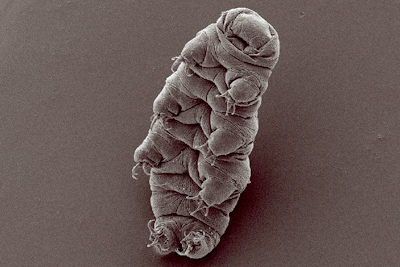Two surprising critters living in the tiny world of moist soil
 The unseen world of soil microbiota is full of surprises: Take, for instance, tiny animals called water bears that thrive in almost any location on Earth (and even outer space) through suspended animation. And even a shape-shifting slime mold that cultivates bacteria in order to harvest it in the future. These are only two of the organisms populating soil—yet there are hundreds of other microcritters on which plants and larger animals rely.
The unseen world of soil microbiota is full of surprises: Take, for instance, tiny animals called water bears that thrive in almost any location on Earth (and even outer space) through suspended animation. And even a shape-shifting slime mold that cultivates bacteria in order to harvest it in the future. These are only two of the organisms populating soil—yet there are hundreds of other microcritters on which plants and larger animals rely.
Water Bears
Water bears, which are named for the bear-like gait with which they walk, use claws at the end of eight pudgy legs to cling to leaves, moss and other debris. Stylets at the end of a tubular mouth pierce plant cells and small invertebrates (and even other water bears in some cases) while a pharynx sucks out the juices. Water bears—officially called tardigrades and also known as moss piglets—possess a compartmentalized brain and nervous system, intestine, eye sockets, anus and, in most cases, gonads. Some species reproduce internally through intercourse while others rely on fertilizing eggs externally.
Water bears are found in moist soil and in extreme environments as well. They also thrive in an ecosystem in Antarctica, in boiling hot springs and can even tolerate long periods (up to a decade) of dehydration. Whereas a majority of living organisms die if exposed to extreme dryness, called dessication, water bears have evolved a unique characteristic:
“They can reversibly enter a state of suspended animation called cryptobiosis, in which their metabolism screeches to a halt and their water content plunges to a hundredth of normal,” as the blog The Artful Amoeba described. “This helps protect their DNA, and a sugar called trehalose helps protect their membranes.”
In addition, water bears are the only animals to survive the radiation-intense, extremely dry vacuum of space—and later recover to breed again.
Slime molds
These are definitely not your garden variety slugs. Technically Dictyostelium discoideum, also called slime molds, are social amoeba commonly found in soil. And despite also being featured in science labs as a model organism, it was not until recently that researchers discovered these single-celled organisms were also avid farmers.
When times get tough, such as when there is a shortage of bacteria for the slime molds to consume, the individual amoebas will join forces to form a slug and migrate to another location. Once it arrives at a suitable locale, the slug again changes shape—this time into a plant-like formation complete with a stalk and a spore. D. discoideum stays “planted” in this shape until food becomes available; then the stalk dies and the spore breaks free to form amoeba once again.
D. discoideum research published this week in Nature added another wrinkle. Debra Brock, a molecular biologist at Rice University in Houston, Texas, and colleagues suggested that this particular species of amoeba harvested bacteria from one location and carried the colonies with it during the slug stage to a new area for later cultivation. In other words, it appears some members of D. discoideum can farm bacteria in the wild. As a Nature News article elaborated:
“When presented with a food source, farmer amoebae stop feeding earlier than their non-farming relatives, and save some food to take with them during their multicellular migration. If they then end up in an area that lacks sufficient edible bacteria, they can rely on their own supply to seed a new population for harvest.”
Photo Credit: Bob Goldstein